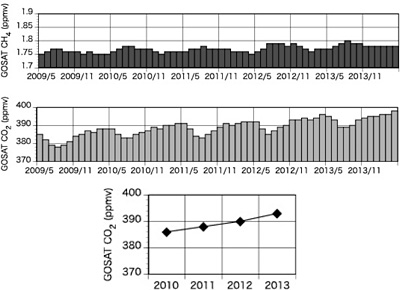
Project Overview
2014
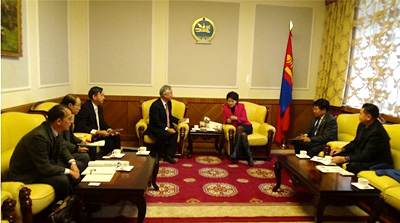
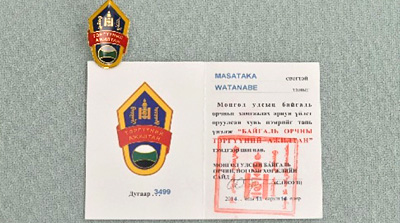
System Structuring for Research and Project
The key purposes of this project are to prevent grassland degradation through green development and to design, propose, and introduce a meat storage system based on freezer storage technology using renewable energy, as well as to establish measurement, reporting, and verification (MRV) methodology to use the Greenhouse Gases Observing Satellite-2 (GOSAT-2) to assess and verify success in reducing emissions of greenhouse gases (GHGs) such as carbon dioxide (CO2) and methane (CH4). In order to implement the project, we created a framework as described below in Mongolia, where the project is under way.
We started by holding a workshop at the National University of Mongolia (NUM) on November 11, 2014, inviting 21 participants from Mongolia, including the Special Envoy for Climate Change at the Ministry of Environment and Green Development (MEGD) and representatives of research institutes affiliated to MEGD, as well as representatives of NUM and government agencies including the National Development Institute of Mongolia (NDI), and environmental policy makers and researchers.
Mongolia’s then Minister of Environment and Green Development, Sanjaasuren Oyun, had observed that Mongolia needed a freezer storage system driven by renewable energy based on implementation of the JCM, and had requested that the project be advanced as a specific policy. In response to this request, we held a workshop at Chuo University on January 13 and 14, 2015, inviting a total of 10 participants from the Mongolian side, including the Counsellor to the Minister for Environment, Green Development and Tourism; the Director of the Institute of Meteorology, Hydrology, and Environment (IMHE); an institute director from NUM; and researchers. The above two workshops enabled both the Mongolian and Japanese sides to confirm what had been agreed with regard to the project’s fundamentals. The workshops also enabled NUM and Chuo University to launch a joint research body, the Institute for Sustainability Development, to set up a joint office, and to sign a memorandum of understanding with the participation of IMHE and NDI.
Within this framework, we put in place a structure to conduct joint testing of freezing and refrigeration systems and other equipment with the help of the NUM’s professors who were conducting research on solar power generation and managing the facility at its Ovorzaisan outdoor test site. The results of these tests were communicated globally via presentation at the UNEP Global Adaptation Network Forum to be held in Panama on March 6 and 7, 2015. Then, on March 17, the role of this joint research project within a series of bilateral policy discussions were described at the Japan-Mongolia Environmental Policy Dialogue to be held in Tokyo.
During fiscal 2014 we used the structure outlined above to implement the following five tasks:
(1) improvement of information gathering, reporting, and assessment relating to mitigation and adaptation in Mongolia’s grasslands;
(2) assessment of the amount of CO2 absorbed by the grasslands;
(3) development of a freezer storage system driven by renewable energy;
(4) social implementation of the freezer storage system; and
(5) investigation of MRV methodology to verify the freezer storage system’s efficacy in reducing emissions of CO2 and other GHGs.
(1) Improvement of information gathering, reporting, and assessment relating to mitigation and adaptation in Mongolia’s grasslands
We started by collecting the data necessary to assess the effects of climate change in Mongolia’s grassland regions. The data we collected comprised information on the past and current climate and natural conditions; statistics relating to society, infrastructure, and the economy; vulnerability to climate change in grassland regions; local herders’ wishes with regard to grassland utilization and grazing; and market information relating to livestock farming. Next, we gathered information relating to adaptation measures and technologies. We examined (i) strategies the Mongolian government is currently considering or implementing as adaptation measures, and associated technologies; (ii) adaptation measures and technologies used in overseas projects that could be feasible in Mongolia; and (iii) strategies international aid agencies are considering or implementing as adaptation measures in Mongolia, and associated technologies. We then drew up a list of the various development strategies and policies and created an overview.
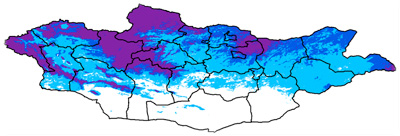
(2) Assessment of the amount of CO2 absorbed by the grasslands
We delegated the relevant work to the National Institute for Environmental Studies, Japan (NIES). NIES installed a CO2 flux observation system at its Nalaikh observation site in Mongolia’s grassland tundra, and used existing terrestrial and satellite observational data to verify the accuracy of ecosystem models. NIES then estimated the amount of CO2 absorbed (between 2001 and 2012) by the surrounding grassland ecosystem, including the test site, and analyzed the differences in distribution between locations that absorbed large amounts of CO2 and those that absorbed small amounts of CO2. NIES also prepared statistical data related to energy and other relevant topics, and developed a database to help understand the relationship between energy generation and consumption of water resources. In addition, it was able to verify the power supply situation in Mongolia, confirming that more than 90% of the sudden demand for electricity in recent years has been met by coal-based production.
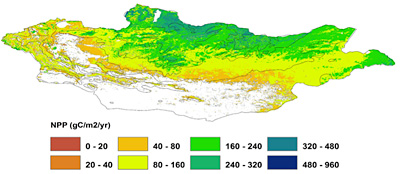
(3) Development of a freezer storage system driven by renewable energy
Jointly with Hitachi, Ltd., we developed a solar-powered freezer storage system and a system to regularly record measurements. Prior to establishing a test facility in Mongolia, we installed a pilot plant in Hitachi’s Matsudo Research Center and conducted a range of tests, including recording the system’s performance and creating a data updating device and checking its performance. Thus we were able to obtain the key data necessary for deploying the system in Mongolia, such as the pilot plant’s operational status and its surrounding environment during operation, enabling us to clarify the issues to be resolved or investigated further before the system could be put in place.

(4) Social implementation of the freezer storage system
This task entailed first of all studying the estimation of meat distribution volumes based on early forecasting. In doing so, we used the data obtained in (1) above. We gathered information on livestock-related issues such as production and consumption, and analyzed the spikes in meat prices and the inadequate meat supplies following the extreme cold weather known in Mongolia as dzud. In addition, we created performance metrics for the productivity of livestock populations according to temperature, precipitation, and quantity of vegetation, and improved the existing algorithms for predicting the occurrence of dzud to develop a vulnerability index. We calculated the rate of decrease in livestock from past livestock movements and compared it with the vulnerability index to analyze potential threshold levels for the index. We then considered possible scenarios for adaptation measures based on setting a threshold and shipping meat products early.
Next, we collaborated with Keio University, and then we analyzed the mismatch between the problems posed by the regulatory regime and the herding communities’ need to preserve meat using the freezer storage system. To this end, we examined the challenges to implementation of the freezer storage system from a range of perspectives: cooperation between governmental ministries and agencies, provision of laws and regulations, methods for monitoring overgrazing and illegal grazing, appointment of a supervisory authority to progress the project, methods for introducing the storage system, subsidies, and awareness of the system among herders.


(5) Investigation of MRV methodology to verify the freezer storage system’s efficacy in reducing emissions of CO2 and other GHGs
We started by studying GHG estimation methods in collaboration with the Overseas Environmental Cooperation Center, Japan (OECC). We used data published by the Mongolian government to keep track of information on GHG emission levels throughout the region, and verified that the energy sector, and combined heat and power plants in particular, tended to account for high emission levels. We also reviewed the literature relating to GOSAT-based GHG estimation methods, verification of data accuracy and its methods. We confirmed that the accuracy of GOSAT observational data is usually validated by means of large terrestrial observation devices or commercial airplanes, and verified the extent of errors in the CO2 and CH4 column amount data publicly distributed as a product of GOSAT. We also investigated with specialists the possibility to capture the amount of CH4 produced by livestock by making use of GOSAT data. We arrived at the conclusion that while this was difficult with currently published data, future GOSAT data and designation of different observational methods would allow capturing the amount of CH4 emissions from animals.
Subsequently, we collaborated with the Japan Research Institute, Limited, to study MRV methodology relating to individual direct or indirect emission reduction activities arising from operation of the freezer storage system. With regard to direct emission reduction activities, we analyzed eligibility criteria, reference scenarios, and other requirements for implementing activities as JCM-based projects, then conducted detailed investigations regarding displacement of electricity from the grid by renewable energy, which could be established as an MRV methodology. For indirect emission reduction activities, we clarified the progress made with investigations under the JCM, primarily with regard to the mechanism for Reducing Emissions from Deforestation and Forest Degradation (REDD), and also identified the issues to be addressed when investigating MRV methodology.
